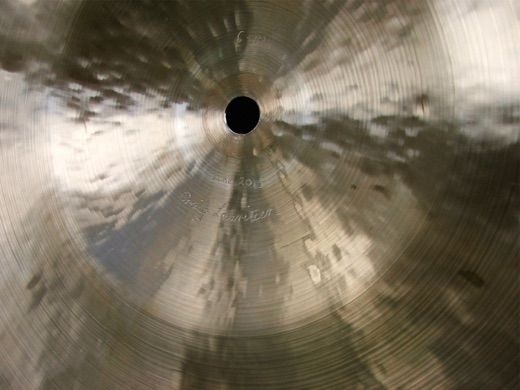Cymbals 101 & Weight Table

CYMBALS 101
THE BASICS –
Cymbals are made from copper based alloys.
Generally, the most desirable is roughly 80% copper and 20% tin and is called B20.
B15 is 85% copper and 15% tin; B10 is 90% copper and 10% tin; B8 is 92% copper and 8% tin etc.
Sometimes other metals are mixed with the copper, as is the case with nickel silver or NS12 which contains 88%copper and 12% nickel.
The higher tin content of B20 means that it is a two phase alloy and the heating ranges during processing are far more critical.
The ingots are heated and rolled in different directions at least 6 times, to reduce the thickness and increase the area of the ingot and tighten the grain structure. This leads to a very musical end product, but is obviously more expensive to produce.
B20 is capable of producing a more complex sounding cymbal with a greater spread.
Striking a cymbal produces a number of fundamental frequencies, each being emitted from a different radial location on the cymbal.
The bell emits the highest frequencies, the main playing area of the bow the mid-range and the edge the lowest frequencies.
Each of these fundamentals has it’s own series of overtones and all of these interact to form a unique sonic ‘fingerprint’ for each cymbal.
The way tension is distributed through the cymbal via shaping and hammering and the way each of the radial areas are connected by tension, greatly affects the sonic characteristics of a cymbal.
A number of parameters combine to influence the sound of a cymbal.
Here are some of the parameters and their effect on the sound, presuming all other parameters are equal.
Tension - the greater the overall tension in a cymbal, the faster the response, the greater the sustain and level of wash.
Diameter – Larger diameter = lower tessitura (voice), slower response, wider spread, longer sustain.
Weight – Heavier weight = higher tessitura, greater volume, slower response, longer sustain, fewer overtones, narrower frequency range, more stick definition (can be ‘pingy’ in heavier cymbals).
Profile – Higher profile = higher tessitura, dryer, less overtones, less spread, slower response, more stick definition.
Taper – Greater taper (change of thickness from bell to edge) = slightly lower tessitura, faster response, shorter decay, slightly more overtones.
Cup or Bell – The bell acts as an amplifier of sound as well. Larger bell = greater volume, faster response, more overtones.
Some Descriptive Terms –
Wash - the complete make up and level of all frequencies, harmonics and inharmonics in the sound emitted after striking a cymbal.
A cymbal can be ‘washy’ without possessing a large ‘spread’.
Spread - the ‘bandwidth’ spanned by the frequency-range in the wash.
Dark - is the presence of a strong fundamental low frequency in the wash and spread of a cymbal, irrespective of the degree of high frequencies that may also be present in the wash.
Trashy - many inharmonic tones (particularly in the mid to high frequency range) of similar presence in the wash, leading to a complex wash of indistinguishable tessitura or voice.
Stick to Wash ratio - sometimes a cymbal will be described as having a 60/40 (or other values) stick to wash ratio. This means that the stick sits slightly above the wash in perceived volume, at a ratio of 60% stick and 40% wash.
There’s been a lot of debate about exact weights for the various categories.
This table was made possible by a number of people from what I think is the
best discussion forum on the net regarding cymbals - www.cymbalholic.com Thanks fellow ‘holics :)
Cymbal Weight Table
For a 22”:
Extra Light - 1900-2100g
Light - 2100-2300g
Medium Light - 2300-2500g
Medium - 2500-2800g
Medium Heavy - 2800-3100g
Heavy - 3100-3500g
Extra Heavy – 3500g and above.
For a 21”:
Ex. Light – 1649-1822g
Light – 1822-1996g
Med. light – 1996-2170g
Med. – 2170-2430g
Med. heavy – 2430-2690g
Heavy – 2690-3037g
Extra Heavy - 3037g and above.
For a 20”:
Extra Light – 1570 – 1735g
Light – 1735 – 1900g
Med. light – 1900 – 2066g
Med. – 2066 – 2314g
Med. Heavy – 2314 – 2562g
Heavy – 2562 – 2892g
Extra Heavy – 2892g and above.
For a 19”:
Ex. Light – 1502-1650g
Light- 1650 - 1806g
Med. light - 1806-1963g
Med. - 1963-2198g
Med. heavy - 2198-2434g
Heavy - 2434-2748g
Extra Heavy - 2748g and above.
Weight corresponding to any given size = weight for a 22" X r squared for that size divided by 121.
Thanks ‘drumaholic’ from www.cymbalholic.com
Here is an online cymbal calculator - https://www.budstein.com/cymbalweight/
